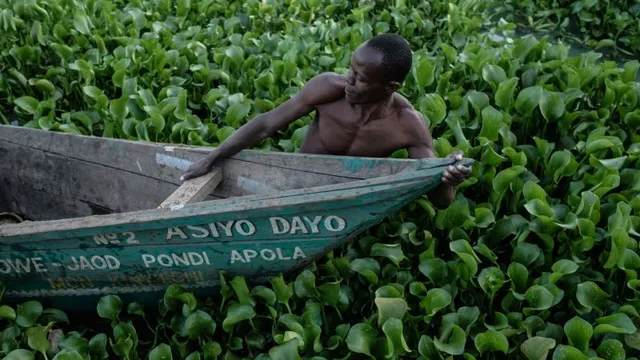
Invasive plant species drain billions from the global economy
2025-01-07 09:21- Invasive water hyacinths significantly disrupt local fishing activities and ecosystems in Lake Naivasha, Kenya.
- Nguthiru and his colleagues form HyaPak to transform the invasive plant into a biodegradable plastic alternative, addressing plastic pollution and environmental degradation.
- The initiative has the potential to aid local communities economically and support reforestation efforts, showcasing an innovative solution to dual crises.
Express your sentiment!
Insights
In Kenya, the invasive water hyacinth has become a significant environmental and economic challenge. Originating from South America, the plant was introduced as an ornamental species, but it has since proliferated and wreaked havoc on local ecosystems. Fishermen like Macharia struggle to fish in Lake Naivasha as the plant's dense growth obstructs their nets, leading to financial losses. This situation has prompted local stakeholders to search for a solution. A group of young entrepreneurs, including Nguthiru, has launched a company called HyaPak, which is dedicated to addressing both the invasive water hyacinth issue and plastic pollution. By gathering harvested water hyacinth from the lake, they have developed a biodegradable plastic alternative that can serve as seedling bags for reforestation efforts in Kenya. This innovation comes in the wake of Kenya's strict regulations against single-use plastics, enacted in 2017, aiming to reduce domestic plastic pollution while incentivizing the community to embrace eco-friendly practices. The bioplastic made from water hyacinth biodegrades over a few months and can be used as an environmentally friendly option for packaging seedlings. Nguthiru and his team introduced this alternative in response to the ongoing diminishing of tree cover in Kenya, where the country has lost approximately 14% of its trees between 2001 and 2023. The expectation is that these seedling bags can assist in the transportation and growth of new trees, addressing both deforestation and invasive species problems simultaneously. HyaPak is already exporting its products to the US and Germany and is looking into expanding its reach to countries like India and El Salvador, which also struggle with water hyacinth infestations. Nguthiru expresses a strong ambition to maximize the impact of this innovation globally, even contemplating the idea of open-sourcing their bioplastic technology for faster global adoption. Recognizing the urgency of tackling climate change, he highlights the responsibility of his generation to foster solutions that can avert impending environmental crises, especially in light of generational failures to act effectively on these issues.
Contexts
Water hyacinth (Eichhornia crassipes), a free-floating aquatic plant native to South America, has become a significant issue in various regions, including Kenya. This invasive species has rapidly proliferated in freshwater systems, causing numerous ecological and social challenges. Its dense mats cover water surfaces, blocking sunlight from reaching aquatic life, disrupting photosynthesis, and ultimately leading to diminished biodiversity. The presence of water hyacinth in lakes and rivers has severely impacted fish populations, as many species depend on submerged vegetation for spawning and foraging. Additionally, the displacement of native plant species further exacerbates the decline of aquatic ecosystems. The ecological ramifications of water hyacinth extend beyond biodiversity loss. The plant alters water quality by increasing organic matter accumulation, which can boost nutrient levels and lead to eutrophication. Eutrophication causes algal blooms that deplete oxygen levels in the water, resulting in hypoxic conditions detrimental to fish and other aquatic organisms. Moreover, as water hyacinth decays, it contributes to the release of toxins and harmful sediments, further threatening aquatic life and compromising the health of larger aquatic ecosystems in Kenya. Beyond ecological impacts, the socioeconomic consequences of water hyacinth infestation are significant. The plant obstructs waterways, hindering transportation and fishing activities vital to local communities. This disruption can lead to decreased fish catch and increased fishing costs, affecting food security and livelihoods. Furthermore, the clogging of irrigation canals and water supply systems poses serious challenges for agricultural productivity, leading to potential food shortages and economic instability in regions heavily reliant on agriculture. Efforts to control water hyacinth have been undertaken, but they often yield mixed results, indicating the need for integrated and sustainable management strategies. Addressing the issues related to water hyacinth in Kenya requires a multifaceted approach. Strategies include biological control through the introduction of natural predators, mechanical management techniques to physically remove the plant, and community engagement initiatives that raise awareness about the importance of preserving local ecosystems. Collaborating with local stakeholders to develop effective and sustainable management practices is crucial to mitigate the impacts of this invasive species. Continued research and monitoring will be vital to understand the long-term effects of water hyacinth on ecosystems and communities, guiding effective interventions and ensuring the health of Kenya's freshwater resources.